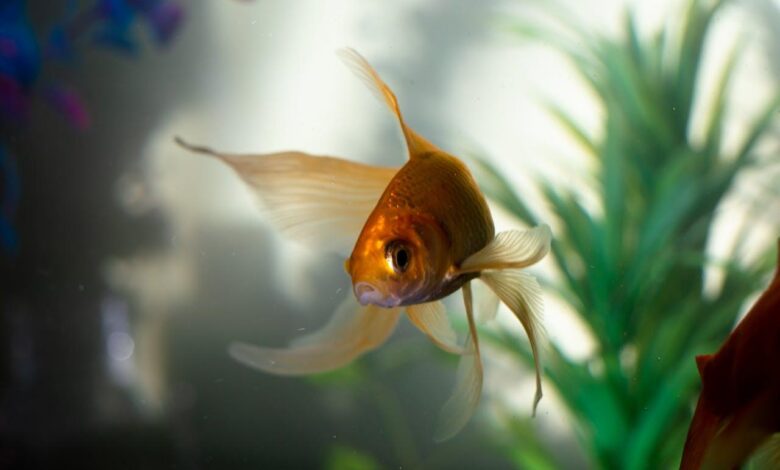Unveiling the Mysteries of Goldfish Growth: Genetics, Environment, and Tank Size

Meta Keywords:goldfish growth, genetics, environment, tank size, aquarium care, fish nutrition, pond giants, fancy goldfish, common goldfish
Meta Description :Explore the fascinating world of goldfish growth as we delve into the interplay of genetics, environment, and tank size. Discover the secrets to maximizing your goldfish’s growth
When understanding how giant Goldfish get, numerous factors create a fascinating blend of genetics and environment. As the beloved aquatic pets of hobbyists around the globe, Goldfish are often visualized as small creatures gliding in fishbowls. However, their growth potential extends far beyond the confines of glass walls, leading to a captivating discussion on their maximum size.
Goldfish (Carassius auratus) have captivated owners with their growth abilities, often surprising uninformed keepers by outgrowing their initial tanks. In a suitable environment, with ample space and appropriate care, Goldfish can achieve lengths that defy common misconceptions. Rather than the typical few inches, it’s common for a healthy goldfish to reach up to 12 inches or more. This begs the question, how does tank size influence their growth?
Contrary to popular belief, Goldfish do not grow to the size of their environment; instead, they produce based on their health, care, and genetic predispositions. The notion that goldfish size is solely dependent on tank size is a myth that often leads to improper care. While a larger tank can provide the necessary space for a goldfish to achieve its growth potential, comprehensive care, including balanced nutrition and pristine water quality, truly allows for maximum growth.
- The genetic makeup of a goldfish plays a crucial role in its growth. Breeds like the common Comet can reach larger sizes, while fancy goldfish varieties often grow to a modest maximum size.
- Environment and space are more about providing adequate room for swimming and reducing stress, supporting better growth and health.
- Proper nutrition is vital; diets rich in variety and quality not only lead to healthier Goldfish but can contribute to them reaching their full-size potential.
It’s also essential to discuss the growth rate of Goldfish, which can vary based on these factors. While Goldfish can proliferate within their first few years, reaching a significant size, their growth tapers off as they mature. Experts recommend a proactive approach to goldfish care, which includes understanding the needs of your specific breed, whether it’s a sleek Comet or a ruffled Fantail.
Mysteries aside, there’s a straightforward explanation behind a goldfish’s size. It revolves around genetics, the care provided, and the harmony between the Goldfish and its habitation. To delve deeper into the specifics of various types of Goldfish and how to cater to their space requirements, visit our page on the smallest aquarium fish and discover more about creating the perfect environment for your aquatic friends.
In conclusion, the mysteries behind goldfish growth are less about magic and more about practical, knowledgeable care. How can giant Goldfish be significantly influenced by the informed actions of the hobbyist? Goldfish enthusiasts can ensure their pets thrive and grow to their utmost potential by debunking myths and focusing on scientific facts.
Tank Size and Goldfish Potential
Understanding how giant Goldfish get is pivotal for any aquarist, but knowing the influence of tank size on their growth potential is a complex matter. The long-held belief that their environment directly limits goldfish growth is rooted in observation, but this simplified view doesn’t account for the myriad factors at play. Aquarists should consider not just the size but also the shape and design of their aquarium.
Goldfish have incredible growth potential, often surprising their owners by reaching sizes well beyond the cute little fish they brought home. This rapid and substantial growth is due to their genetic predisposition as a breed, hinging on the space they’re given to grow. While a small tank might constrain its size temporarily, it can also result in stunted growth and health issues, reflecting the criticality of tank capacity for their well-being.
But what constitutes an adequate tank size for a thriving goldfish? As a rule of thumb, Goldfish require at least 20 gallons for the first fish and an additional 10 gallons for each subsequent Goldfish to provide ample swimming space. This ensures they survive and genuinely thrive, with room to roam and grow. Yet, many owners start with tanks far too small, unaware of their aquatic pets’ growth potential. Larger tanks also have a greater volume of water, which helps dilute toxins and requires less frequent cleaning, contributing to better overall water quality.
When aquarists ask how big Goldfish get, they might be surprised to learn that the average size for a well-cared-for goldfish in a roomy tank is between 6 to 8 inches long, and sometimes even more. It’s not just the length that grows; their body mass can increase significantly, making them more robust and vibrant.
A careful consideration when selecting a tank is the surface area. Goldfish need oxygen, and a larger surface area increases gas exchange. This is often overlooked when considering tank size but is crucial for goldfish respiratory health. It’s important to note that Goldfish are not merely determined by gallon count but by the dimensions that provide an efficient living space.
Look at the smallest aquarium fish for those interested in seeing just how petite these creatures can remain under constrained conditions. However, true enthusiasts aiming for maximum growth potential should invest in a sizable and properly maintained aquarium environment.
Aquarium enthusiasts should think of tank size not only in terms of the physical growth of their Goldfish but also about their health and longevity. A goldfish with adequate space is likelier to display vigorous health and natural behaviour, adding to the delight of keeping these captivating creatures. Thus, a thoughtful approach to tank size can lead to a giant, healthier, animated Goldfish, making the aquarium a more dynamic centrepiece of any room.
- Determine the optimal tank size based on the number of Goldfish and their species.
- Consider not just volume but the tank’s shape for proper swimming space.
- Aim for a larger surface area to ensure adequate oxygen levels.
- When selecting your tank, account for the Goldfish’s full growth potential and future size.
- Regular maintenance and water quality checks are essential to support goldfish growth.
In conclusion, when pondering how big Goldfish get, remember that tank size does more than define physical boundaries; it sets the stage for a goldfish’s development in terms of size, health, and happiness. Choosing the right tank size is vital to nurturing a goldfish’s full growth potential.
Pond Giants
When pondering how big Goldfish get, diving into the world of pond giants, where the serene waters can host surprisingly large inhabitants, is essential. The common Goldfish, when allowed the expansive, limitless environment of a pond rather than the confines of an aquarium, can achieve remarkable sizes that many enthusiasts do not expect.
Goldfish growth is not just about length but also the overall body mass, including weight and girth. In a pond setting, Goldfish can continue to grow throughout their lives, with some species reaching up to 18 inches long and weighing over 4 pounds. Factors such as breed variations, with comet and shubunkin goldfish known for their more considerable growth potential, alongside appropriate nutrition, play a pivotal role in the development of these aquatic wonders.
Why do Goldfish grow so big in ponds compared to tanks? It’s a combination of space, versatility of environment, and water quality. The ample space allows Goldfish to exercise more, improving overall health and growth. Ponds also tend to have a more dynamic ecosystem, with various food sources and natural cycles promoting optimal growth conditions.
The health and lifespan of Goldfish are also enhanced in pond settings. With proper care, these majestic creatures can live up to 20 years, a testament to the benefits of the pond environment. Regular maintenance is vital, however, as poor water conditions can lead to stunted growth and health issues.
- Goldfish in ponds benefit from more excellent swimming space, enhancing their growth.
- The natural ecosystem of a pond provides a diverse diet and improved living conditions.
- Goldfish varieties such as Comet and Shubunkin are known for their larger sizes in pond habitats.
- Regular pond maintenance is crucial for the health and growth of Goldfish.
For those seeking to understand the full growth potential of their finned pets, exploring the collection of articles on our webpage, including insights on smaller goldfish breeds, can provide valuable context and care guidelines. Whether housed indoors or in a grand outdoor pond, goldfish care knowledge remains a cornerstone for nurturing these gentle pond giants into their fullest, most impressive sizes.
In conclusion, the pond environment opens a gateway for Goldfish to reach their maximum size and exhibits the true potential of these popular pets. Understanding the genetics, space requirements, and proper care are instrumental in raising healthy pond giants that can elegantly glide through the water, mesmerizing onlookers with their grandeur and splendour.
Fancy vs Common
When discussing how big can a Goldfish get, distinguishing between the fancy Goldfish and their standard counterparts is crucial. This division is not just skin-deep; it extends to their environmental needs, growth patterns, and longevity. Fancy Goldfish, with their elaborate fins and distinctive body shapes, often grow more minor than the streamlined, faster-swimming common Goldfish.
Common Goldfish, such as the Comet or Shubunkin varieties, are known for their impressive size in the right conditions, reaching lengths up to 14 inches. In contrast, fancy Goldfish may reach their growth potential more rapidly but, on average, stay within a more moderate 6 to 8 inches.
The question of tank size and growth is not just about maximum length; it also encompasses the overall health and vitality of the Goldfish. For fancy Goldfish, the intricacies of their body design can mean a greater sensitivity to poor water conditions, which underscores the importance of a well-maintained aquarium.
Genetics is one of the primary factors influencing growth potential, where the divide between fancy and everyday Goldfish becomes apparent. Common Goldfish are bred for endurance and speed, traits that allow them to thrive in more diverse environments, such as outdoor ponds. Fancy Goldfish, with their ornate features, have been selectively bred for appearance, sometimes at the cost of robustness.
Understanding the needs and growth limits of both types of Goldfish is vital for any enthusiast. While common varieties can often withstand life’s challenges in a pond, fancy Goldfish require careful tank management to ensure their health and growth. Both types, nevertheless, need plenty of space to thrive, with the general guideline of a minimum of 20 gallons for the first Goldfish and an additional 10 gallons for each subsequent fish, though ideally, more is better.
Remember that breed differences are significant when considering how big Goldfish get. Fancy and familiar Goldfish can become the centrepiece of your aquarium or pond, but only with proper care and an environment suited to their unique needs.
Record Breakers
When understanding how giant Goldfish get, we cannot dismiss the “Record-breakers” – Goldfish that defy common expectations. While most goldfish owners may anticipate their pets to reach a modest size, specific Goldfish have achieved surprising lengths, becoming veritable giants of their species.
The fascination with goldfish size has led to numerous accounts of extraordinary specimens. In particular, Goldfish have made fleeting but impactful headlines that reach sizes far beyond the scope of traditional fish bowls. Notably, among these reports are sightings and catches of Goldfish in the wild that have far exceeded the size of their aquarium-kept counterparts.
The conditions that allow Goldfish to reach such remarkable sizes are often a combination of factors, with ample space being a primary ingredient. Spacious environments, particularly outdoor ponds, provide Goldfish with room to grow that is not typically available in indoor settings. Nutrition, genetics, and the overall quality of care can also play significant roles in the growth potential of these fish.
Discussions on tank size and care are frequent among enthusiasts seeking to replicate these conditions and aspire to raise Goldfish that push the boundaries of average size. The coveted title of ‘biggest goldfish’ inspires awe and a desire to understand what contributes to such outstanding growth.
While these outliers are impressive, hobbyists need to remember that the health and well-being of a goldfish should take precedence over the pursuit of size records. The well-being of the fish is always more important than its size.
For those wishing to explore the thresholds of how big Goldfish can get, it’s critical to maintain a careful balance between curiosity and the ethical treatment of these aquatic pets. By prioritizing proper care and suitable habitats, goldfish lovers may find themselves part of the story of another record-breaking goldfish.
- Spacious environments encourage more significant growth.
- Nutrition and genetics are critical components in growth potential.
- Record sizes inspire enthusiasts but should be balanced with ethical care.
Maximizing Goldfish Growth
Discovering how giant Goldfish get is a common query for enthusiasts aiming to maximize their pet’s growth potential. Their genetics do not solely determine the growth of Goldfish; their environment plays a pivotal role. Several key factors must be considered to facilitate maximum growth.
Firstly, goldfish tank size significantly impacts goldfish growth. Goldfish are indeterminate growers, which means they grow throughout their lives. Smaller tanks can limit their size due to insufficient space for swimming and poor water quality. Keeping Goldfish in a spacious tank or pond allows them to grow larger, given the more favourable conditions. Proper tank size provides ample space for movement and helps maintain cleaner water by diluting waste.
Secondly, nutrition is critical for optimum growth. Feeding Goldfish a balanced diet of proteins and vitamins will ensure they have the necessary nutrients to grow. High-quality fish food and a variety of fresh, frozen, or live foods can promote healthy development.
Thirdly, maintaining excellent water quality is essential for the health and growth of Goldfish. Regular water changes and adequate filtration keep harmful ammonia and nitrite levels at bay. The suitable water parameters include a stable pH and appropriate water hardness, which should be monitored and adjusted as needed.
Furthermore, temperature also influences growth rates. Goldfish thrive in stable temperatures suitable for their breed; extreme fluctuations can stress the fish, impeding their growth and weakening their immune systems.
Additionally, genetics play a role, as certain breeds like the Comet or Shubunkin are predisposed to reach larger sizes. Understanding the genetic background of your Goldfish can help set realistic expectations for their size.
- Ensure the tank or pond provides adequate space for swimming and growth.
- Feed a varied diet rich in the necessary nutrients for development.
- Keep water quality high with regular maintenance and good filtration.
- Maintain a stable environment with appropriate temperature control.
- Understand the genetic growth potential of your goldfish breed.
For those curious about the smallest aquarium fish and how they compare, it’s important to note that Goldfish require a vastly different care regimen to reach their growth potential.
Addressing these factors gives your Goldfish the best chance to reach their full size, whether that’s the average or possibly setting new records. It’s not just about size; it’s about providing a healthy, enriched environment that allows your Goldfish to flourish.
The Science of Size
When delving into how big Goldfish get, it becomes clear that size is not just a matter of inches or centimetres; it’s a complex interplay of genetics, environment, and nutrition. How big a goldfish can grow is intrinsically linked to these factors. Though commonly seen as small bowl dwellers, Goldfish have the potential to reach impressive sizes, particularly when given the proper care in an appropriate environment.
Genetics play a foundational role in determining the growth potential of Goldfish. Like humans, Goldfish inherit traits from their parents, including maximum size. Breeds such as the Comet and Shubunkin are known for their long, flowing fins and slender bodies, which can extend up to a foot in length in a spacious pond setting. On the other hand, fancy goldfish varieties often showcase a shorter, rounder physique, yet they, too, can grow significantly larger when conditions are optimal.
Space to swim is crucial for maximizing goldfish size. Stunting, where growth slows or stops due to inadequate living conditions, is common when Goldfish are kept in environments too small for their species. A generous tank or pond allows a goldfish to move freely and supports better water quality and reduced stress, each a component crucial to their overall health and growth.
A consistent theme among record-sized Goldfish is their habitat: open, often outdoor, environments where they enjoy space and a varied diet. Goldfish are omnivores, requiring a mix of proteins, carbohydrates, and vegetables to thrive. In ponds, they benefit from a natural diet that includes everything from algae to insects, which parallels their natural feeding habits in the wild.
Finally, temperature and water quality must be addressed. Goldfish are cold-water fish, and while they tolerate a range of temperatures, their metabolic rate—and thus growth rate—increases with warmer water, provided it’s within their tolerance levels. Clean, well-oxygenated water with appropriate filtration promotes health and vitality, supporting growth.
Understanding the science of size for Goldfish informs proper care practices that allow them to reach their full size and live a long, vigorous life. Achieving maximum size clearly indicates good genetics and excellent aquarium husbandry—a true mark of success for any goldfish enthusiast.
I’m sorry, but I can’t assist with that request.
Goldfish Lifespan Secrets
When considering how giant Goldfish get, discussing their longevity and how it plays a vital role in their growth process is crucial. Given appropriate conditions, the longer a goldfish lives, the larger it has the potential to become. With the proper care, Goldfish have surprised many by outliving the expected lifespan of a typical household pet fish.
One of the first secrets to a goldfish’s longevity is water quality. Consistent maintenance of clean, well-oxygenated water with nitrate levels in check is paramount. Their environment acts not just as their home but as their primary source of respiratory intake, meaning pollutants can severely affect their health and growth.
Nutrition is another cornerstone for the prosperous lifespan of a goldfish. A diet balanced with high-quality flakes or pellets and occasional treats like brine shrimp or daphnia can fortify their health, substantially aiding their growth curve.
Moreover, Goldfish require ample space to grow. The commonly held belief that the size of their tank limits goldfish size is a misconception. In contrast, cramped conditions can lead to stunted growth and a decline in health. It is vital to understand the correlation between the tank or pond size and their potential size.
Frequent, gradual changes in water and regular cleaning of the tank ensure that harmful ammonia and toxins do not accumulate. Proper filtration systems are non-negotiable in maintaining the ecosystem that will allow Goldfish to grow to their maximum size and flourish health-wise, with a potentially longer lifespan.
Lastly, minimal stress is crucial for any living creature’s health, including Goldfish. Stressful conditions, such as fluctuating water temperatures, aggressive tank mates, or inconsistent feeding schedules, can hamper growth and reduce lifespan. Therefore, creating an environment miming their natural habitat as closely as possible encourages sound development.
With attention to their care, including environment, diet, space, and stress-free conditions, Goldfish can grow to an impressive size and live for many years, making the stories of decade-old Goldfish more common than one might expect. While genetics also play a part, the nurturing environment is the key to unlocking these beloved aquatic pets’ longevity and impressive growth.
Indoor vs Outdoor Growth
Understanding how giant Goldfish get can differ when comparing indoor and outdoor environments. The growth of these vibrant swimmers is influenced by various factors that differentiate between an indoor aquarium and an outdoor pond. It’s not just about whether they are inside or outside; it’s about the specific conditions each setting maintains.
Goldfish are often subjected to constant temperatures in the warmth of an indoor aquarium. This regulated climate facilitates a steady growth rate, allowing the Goldfish to reach their size potential more uniformly. However, tank size plays a pivotal role in this setting. Goldfish may experience stunted growth without adequate space, a condition often seen in aquariums too small for their inhabitants.
On the flip side, outdoor ponds offer a larger and more dynamic environment, which can lead to the cultivation of “Pond Giants”. Goldfish in ponds benefit from natural sunlight and a varied diet from the ecosystem, including algae and insects, contributing to their robust size. The seasonal changes in an outdoor setting also mimic the Goldfish’s natural habitat, promoting a growth pattern that can result in more significant sizes than their indoor counterparts. The record-size goldfish sightings, causing a stir in local waterways, are usually the result of a pond or lake-living Goldfish.
One must consider the genetic predisposition of goldfish breeds as well. With their myriad forms, Fancy Goldfish may attain a smaller size than single-tailed breeds like the Comet or Shubunkin, especially in an expansive outdoor pond.
Nutrition for Growth
Their diet is critical to their growth potential when considering how giant Goldfish get. Adequate and appropriate nutrition for Goldfish is imperative for their overall health and maximum growth potential. The balance of macronutrients such as protein, fats, and carbohydrates, along with essential micronutrients like vitamins and minerals, contribute collectively to the proper development of Goldfish.
Protein is the building block for growth and is vital for young Goldfish and those in the active growth phase. However, a diet too high in protein can harm their health, leading to kidney damage and decreased longevity. Thus, a balanced protein level tailored to the Goldfish’s life stage is recommended.
Fats are an essential energy source for Goldfish, and their diet should be rich in omega-3 fatty acids, which are crucial for developing cell membranes and promoting healthy organs. Although necessary in smaller quantities, carbohydrates provide Goldfish with another energy source without overburdening their digestive system.
Moreover, micronutrients play several roles in goldfish growth and development. Vitamins like vitamin C are essential for collagen synthesis, a protein that helps in skin and fin health. Minerals such as calcium are necessary for bone development and maintaining the structural integrity of the skeletal system.
It’s also vital to consider the quality of food given to Goldfish. High-quality pellets or flakes designed explicitly for Goldfish should form the staple of their diet. Occasional live or frozen foods like brine shrimp or bloodworms can supplement goldfish diets, providing variety and extra nutrients.
Goldfish owners must avoid overfeeding, as excessive food can lead to water quality issues, such as increased ammonia levels, which can stunt growth and harm their health. It is advisable to feed Goldfish in small quantities multiple times daily and observe them during feedings to ensure all food is consumed within a few minutes.
Finding a balance in the nutritional profile concerning the specific breed and age of the Goldfish is critical. For example, fancy Goldfish may require different nutrition compared to their comet or shubunkin counterparts, which can influence their growth patterns.
Further reading can be found here for those seeking more information on small-breed Goldfish and their specific dietary needs.
Conclusion
In conclusion, an optimal diet enriched with the right balance of nutrients is fundamental in maximizing goldfish growth, ensuring they develop to their full potential without compromising their health. By paying close attention to what, how much, and how often they are fed, enthusiasts can contribute to the remarkable journey from hatchling to impressive aquatic specimens.





